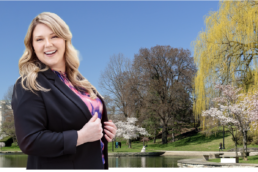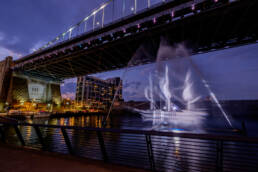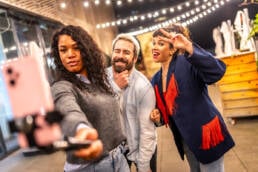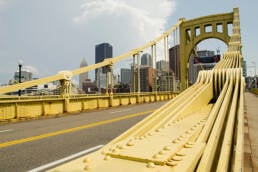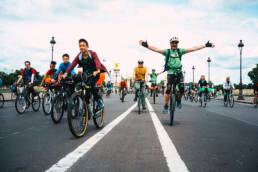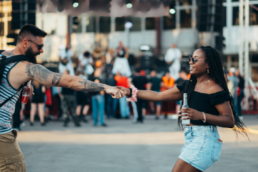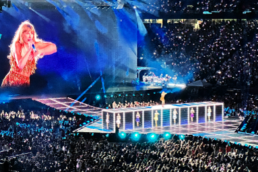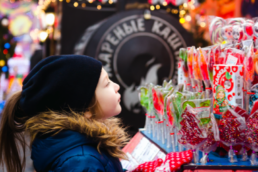The terms placemaking and place branding have been bandied about so much across so many industries they are now crossing over into the gen pop vernacular. But we, as place management practitioners, hold placemaking near and dear to our hearts. It’s a crucial element or overarching approach to nearly everything we do for our districts. And whether you’re responsible for operations, clean and safe, marketing, events and activations, programming, special projects, community engagement — or even social and MarCom — placemaking pervades nearly everything we do.
Before the pandemic, our co-founder Josh Yeager participated in the IDA Top Issues Council on Placemaking. Together with a whip-smart coalition of IDA members, practitioners, and some downright innovative folks, they collectively developed this publication on Place Branding (FREE for IDA Members) and produced and hosted IDA’s first-ever Placemaking and Place Branding Summit in Huntsville, AL. The pandemic put the brakes on subsequent summits, but the information, insights, and inspiration from the report are all still applicable, albeit perhaps with a few post-pandemic tweaks.
And that’s mainly what we’re exploring in this section. No need to say it again, but the pandemic up-ended so many aspects of our lives that, culturally, we’re a different bunch now. Downtowns and districts globally have different concerns, pressures, merchant support needs, dayparting, and foot traffic patterns. So within this section, we’ll delve into today’s world of placemaking and guide you through some examples of outstanding placemaking globally.
Also, never forget to check our website’s RESOURCES section for additional Trends Reports (like this on Illuminated Placemaking) and an archive of our bi-monthly e-blasts for place management practitioners and destination marketing organizations, the Bright Brothers Bulletin.
EXPERIENTIAL
We talk all the time about “leaning into experiential” locally, but what does that mean? A great answer comes from Senior Business Director of Experiential, Victoria Sobel from lauded creative agency Giant Spoon. Known for groundbreaking and impressive, immersive experiences, Giant Spoon caught the world’s attention last year by turning upside down the Empire State Building (and 14 other iconic landmarks globally) to tease the launch of Stranger Things, season 4. If you haven’t seen the activation, click here to enter The Upside Down.
Sobel stated in a recent interview with Marketing Brew, “Consumers now look to brands to do more than just demo and sample—they want to participate, learn, celebrate, and ultimately, be part of a community through these shared moments. Marketers should lean into this opportunity to build brand love and loyalty through the creation of great, memorable experiences,” and that Empire State stunt definitely checks all the boxes!²⁰
Now, most urban place managers don’t have the kinds of big budgets that Netflix has to promote their districts. So what is possible? Plenty! Think about things you and your stakeholders can do, like:
- Philly’s famed Pizzeria Beddia has a private omakase hoagie room. Based on the Japanese tradition of omakase, guests participate in the preparation of the food
- Host an in-shop experience à la Lush cosmetics, the famed British beauty brand
- Sleepovers are an increasingly popular trend at museums, zoos, and cultural attractions
- The Tinder Pride Slide was not only a trip, but it was also a feel-good fundraiser
- This innovative lighting manufacturer, RBW, hosts lunch-and-learns with architects and designers (their target audiences) and interactive public events where participants assemble a lighting fixture and take it home
- And then, of course, you have your vetted experiential business models like Build-A-Bear, Wine & Design (aka “tipsy painting”), and chefs classes…
- Plus, experiential exhibits like The Van Gogh Immersive Experience, Luminarias in the Garden, the Museum of Ice Cream, and many more.
- If you have an influx of new residents to your district, consider programming “locals only” fam tours, dine-arounds, or bike and burrito rallies!
Taking a deeper dive into experiential and illuminated placemaking, consider the Downtown San Francisco Partnership’s ‘Let’s Glow SF” event.* With two seasons under their belts, the downtown district tirelessly works to counter the media narrative that the central business district is dead. The media in SF itself loves to jump on this narrative to garner alarmist clicks. Admittedly San Francisco’s commercial real estate market has been particularly hard hit with pandemic pitfalls, like major tech companies moving to WFH as standard, Twitter getting hit for past due rent, and more.²¹
In an effort to keep office workers downtown after hours, (and spending money on local stakeholders), as well as draw locals, regionals, and visitors to SF’s extremely clean and safe downtown, the district launched Let’s Glow SF during holiday 2021 to much fanfare, plus a special honor from Mayor London Breed. The 10-day event massively increased foot traffic and drove an estimated $2.2M economic impact for the districts’ ratepayers. In 2022, Let’s Glow returned as the nation’s “largest holiday projection mapping festival,” featuring spectacular light shows at five iconic locations within the district, and 2022 knocked it even farther outta the park with a 42% increase in attendance and a 61% increase in visitor spending, creating a $3M economic impact for Downtown SF businesses.
The district worked with a local visual arts company A3 Visual, and tapped local and international talent to design the interactive displays and light shows. In 2022, they offered a digital brochure and added a companion print guide to the festival that was distributed to local tourism and hospitality partners. It all adds up to quantifiable returns for the community, and even in San Francisco, $3M in economic impact is nothing to sniff at!
Get the full scoop on Let’s Glow SF on the Downtown San Francisco Partnership’s new website!
Now not every district has the budget, foot traffic, or wherewithal to produce this type of event, but a key component here was also dayparting.
DAYPARTING
Because of the pandemic, we now have disrupted foot traffic patterns, WFH and more flexible work schedules, different child care situations, and hybrid work scenarios creating fractured dayparts. In some cities, we’re seeing rebounds in daily commutes returning to some 80-90% of pre-pandemic levels, and in other places (like San Francisco), we may never return to a formerly-known norm. So what does this mean for districts? Nearly every one of our clients has expressed challenges pertaining to this disruption. It’s difficult for restaurants to staff for lunch without the office workers. Some cities have seen a “brain drain” of talent that can work virtually anywhere and have moved off-grid. And in some places, businesses are mandating a return to the office with varying degrees of success. So what to do?
Lean into dayparting. And what that means is understanding when and where people are coming downtown, and programming and activating for those segments. It may not be the traditional “after-work happy hours” and coffee meetings anymore. We highly recommend you track and analyze foot traffic patterns (with any of the myriad services like Springboard, Placer.ai, and others), to better understand when and how people are using your downtown amenities. Once you have a grasp on when, you can get the most bang for your buck, program for these visitors, and make sure it ties into your merchant support efforts. Some examples come to mind, like:
- Downtown Tempe’s “Park After Dark” series takes palace after sunset during their blistering summer months
- Recurring concert series during alternate dayparts like lunch, happy hour, and weekend evenings, like Downtown Pittsburgh Partnership’s “Downtown Sound” series
- Consider round-ups of content/programming around mid-afternoon sweet treats and pick-me-ups like Visit Chandler cataloged
- …or even consider go-at-your-own-pace programming like Downtown Austin’s “Mural Map,” Downtown Huntsville’s “Craft Beer Trail,” Downtown Excelsior Springs Chocolate Tour, wine tours, cocktail trails, and more.
CHANGE
Once the genie is out of the bottle, it’s never going back. We’re now three years into COVID-19 first hit, and the word “pivot” has been beaten like a dead horse (pardon the analogy). But let’s explore how some places lean into change.
“Car-free” frees up space for people. Even before the pandemic, we saw the beginnings of car-free movements in cities around the globe. With Europe taking a decided lead over the U.S.’s love affair with the automobile, cities like Barcelona, Milan, Paris, and Stockholm are ahead of the curve in implementing Open Streets programs — bringing a more human scale to safe and exclusive streets for pedestrians.²² And stateside, we’ve seen massive inroads made in cities like Atlanta, Boulder, Columbus, Fort Collins, Fort Lauderdale, Minneapolis, Pittsburgh, Philly, Portland, and more.
Additionally, streeteries lending a slim lifeline to struggling restaurants during the pandemic, are now becoming permanent in cities like New York, Philadelphia, San Francisco, Seattle and many more, albeit not without contention. Some cities (and citizens) favor parking over pizza, and making streeteries permanent comes with a hefty price tag for safety, stability, insurance, and inspections.
But in one of the most telling stories, the city of Toronto, CA recently announced some quantifiable evidence in favor of permanent street eats. In late 2022 Toronto published their analysis on revenue generation from the same footprint of space, year-over-year. They found that had the traditional parking been in place, it would have generated a mere $3.7M, compared to the $181M produced by curbside patios during the same 13-week study period. That’s 49X more revenue generated for the city, and its citizens are seemingly stuffed and satisfied with the results as well!
Use of the public realm became even more imperative during the pandemic, often with surprising outcomes. One street in Jackson Heights, a dense, bustling neighborhood in Queens, NY closed 34th Avenue to traffic during the pandemic, and residents and businesses liked the expanded, outdoor space so much, the Department of Transportation agreed to make the change to an Open Street permanent. Managed by the 34th Ave Open Streets Coalition, this success story is but one example of thousands implemented worldwide due to COVID-19’s social distancing protocols and efforts to make places more liveable.
Jackson Heights, NY resident and Department Chair at William Paterson University, Lauren Razzore-Cedeño endured most of the pandemic in this neighborhood. She shared personal insights with Bright Brothers Strategy Group, noting that, “What transpired and transformed 34th Avenue was honestly a lifesaver for us,” stated Razzore-Cedeño, a mother of two young children.
She furthered that, “New York was the epicenter of the pandemic at the time. We had nowhere to walk because it wasn’t safe on the sidewalks packed with so many people… we couldn’t socially distance. So I would take the girls down there for fresh air. It started just as a place to get some space during COVID, but they developed programming on 34th, and the whole scene became a really amazing community space. Some neighbors weren’t happy with the changes, but it really provided a lifeline for me and my family.”
So whether for walking, playing games, yoga, dining, dancing, bike rallies or myriad other purposes, the trend toward creating safe, human-scale, car-free spaces within our districts and cities is a trend we’re likely continue to see develop in 2023 and beyond.


